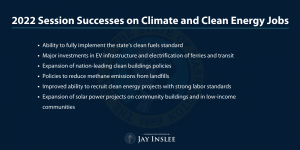Program Summary from the Department of Ecology, State of Washington, 2021 & 2022
The Climate Commitment Act (CCA) caps and reduces greenhouse gas (GHG) emissions from Washington’s largest emitting sources and industries, allowing businesses to find the most efficient path to lower carbon emissions. This powerful program works alongside other critical climate policies to help Washington achieve its commitment to reducing GHG emissions by 95% by 2050.
The CCA also puts environmental justice and equity at the center of climate policy, making sure communities that bear the greatest burdens from air pollution today see cleaner, healthier air as the state cuts greenhouse gases. Finally, funds from the auction of emission allowances will support new investments in climate-resiliency programs, clean transportation, and addressing health disparities across the state.
A market-based solution ~ In the CCA, the Legislature directed us to design and implement a cap-and-invest program to reduce statewide GHG emissions. This program works by setting an emissions limit, or cap, and then lowering that cap over time to ensure Washington meets the GHG reduction commitments set in state law.
Only the second such program in the U.S., cap-and-invest uses the powers of supply and demand to incentivize businesses to cut their emissions, using whatever strategy they think is best.
Building a sustainable market ~ The Legislature also tasked Ecology with designing the program so that it could, potentially, be linked with similar programs in California and Québec, which already share a combined carbon market. Based on an independent economic analysis commissioned as part of our current rulemaking for Chapter 173-446 WAC, Ecology will begin a public process to explore the possibility of linking in early 2023.
Cleaner air for overburdened communities ~ The CCA aligns with the requirements of the Healthy Environment for All (HEAL) Act and includes provisions to ensure communities in Washington that are disproportionately impacted by climate change and air pollution benefit from cleaner air.
In addition to the GHG reductions that will result from the cap-and-invest program, the CCA also directs us to reduce “criteria” air pollutants — such as ozone and particulate matter — in overburdened communities highly impacted by air pollution.
Funding allocation and accountability ~ The CCA also directs the Environmental Justice Council to make recommendations to the Legislature on how auction revenue should be used and requires agencies using funding from CCA accounts to report their progress toward environmental justice goals to the Council.
Investing in the future ~ Under the law, proceeds from the CCA allowance auctions must be invested in critical climate projects focused on improving clean transportation options — increasing climate resilience in ecosystems and communities — and addressing issues of environmental justice and health inequity in Washington.

Importantly, the CCA requires that at least 35% of funds be invested in projects that benefit overburdened communities, and a minimum of 10% go to projects with tribal support.

